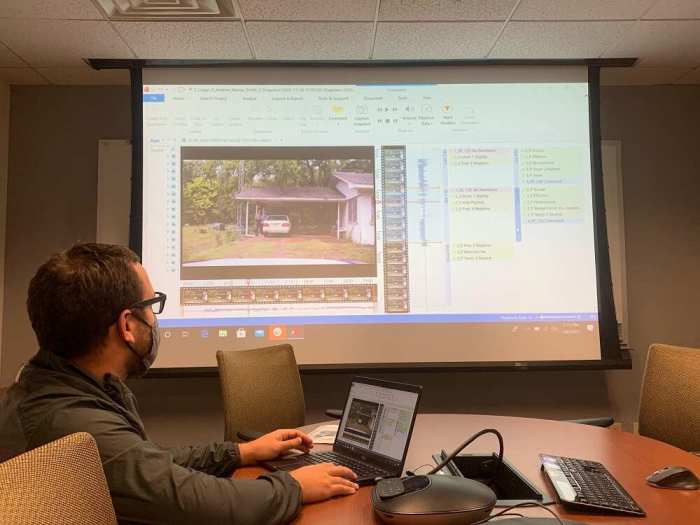U.S Department of Homeland Security (S&T)2021-03-04 10:26:00
Leveraging Partnerships to De-escalate Conflict in Law Enforcement Encounters
Managing conflicts is an integral aspect of law enforcement, but the many nuances of personal interactions can make it challenging and situations can quickly escalate to dangerous levels. The Department of Homeland Security (DHS) Science and Technology Directorate (S&T) is conducting research to learn more about these interactions, with a focus on de-escalation methods. The aim of this effort is to identify effective conflict resolution strategies by reviewing video footage of police encounters, coding them to classify behaviors and outcomes, and detecting patterns that can inform future training.
ASU student reviewing video footage of a police encounter and coding it to classify behavior and outcome.To assist with this study, S&T’s partners at the Federal Law Enforcement Training Centers (FLETC) asked the Dallas, Texas, Police Department and Smith County, Texas, Sheriff’s Office to provide video footage of recent police encounters. “The footage they gave us included traffic stops, encounters with individuals in distress, suspicious person calls, encounters with homeless individuals, and more,” said Dr. Laura Zimmerman, FLETC Senior Researcher. “The goal is to gather information from the footage about current practices used in the field. We want to learn what helps to keep a situation from escalating or what helps to de-escalate a situation. We’re hoping to find behavioral consistencies across the video footage.”
FLETC is collaborating with the DHS Center of Excellence at Arizona State University’s (ASU) Center for Accelerating Operational Efficiency to identify the verbal and physical behaviors police use to manage conflict and to potentially develop models that indicate patterns of response. Since the project kicked-off in May 2020, FLETC and researchers from ASU’s School of Criminology and Criminal Justice have been completing the video coding and analysis process. When finished, they will identify training content based on the data, and expect to publish results for law enforcement and academic communities by mid-summer.
“We use a software program that allows us to mark segments in each video and code officer and community member behaviors as they interact. Once the coding is done, the codes are entered into an Excel sheet and transferred into a statistical software program where the analysis is done,” said Dr. Zimmerman. “The coding process is quite extensive and challenging. We want to make sure to capture all the behaviors that may influence the interactions.”
“We use the coding scheme to study and document the interaction captured on video between officers and civilians in different response settings,” said Jim Grove, S&T’s FLETC Portfolio Manager. “We hope to discover things that are unique, that work, that don’t work, what results in escalation versus de-escalation.”
DHS efforts to assess and incorporate more effective de-escalation strategies date back to April 2017, when FLETC’s Behavioral Science Division (BSD) reviewed its Conflict Management training course and began looking into communication strategies associated with the concept of de-escalation. BSD met with researchers from FLETC’s Training and Innovation Operations Branch (TIOB) to explore the possibility of conducting research that would identify the tactics used by police officers to manage conflicts and de-escalate situations in real-world settings.
Together, BSD and TIOB developed a plan that leveraged research literature incorporating suspect resistance and use-of-force models, enabling researchers to examine the social interactions that occur in patrol situations. The goal is to identify any pattern of behavior that consistently produces positive outcomes, such as lower levels of officer force, reduced citizen resistance levels, and increased citizen compliance and cooperation. The ultimate objective is to produce findings that guide training for federal, state and local law enforcement.
“We want to identify any patterns of behavior that tend to work in real world environments and use this knowledge to inform training. And if we see behaviors that don’t seem to work, we can recommend toning those down in practice,” said Dr. Zimmerman.
Following this initial project, DHS S&T and FLETC will explore the possibility of developing an intelligent automated coding system that both researchers and law enforcement agencies can use to further answer questions about the complex social interactions that occur between officers and citizens.
“We hope this manual coding can be converted to an algorithm,” said Grove. “If this can be automated, it could be a tool that is applied throughout law enforcement at the local level to help improve training, community relations, personally improve officer skills, show trends that work and don’t work, and maybe even identify where new training delivered is or isn’t having an impact.”
An algorithm relating the interactions of law enforcement and civilians could be used by law enforcement agencies to assess body worn and other videos. Ultimately, all this information could be used to improve individual and departmental training on how to manage conflicts with civilians.
For more information contact:
Science And Technology
Washington DC
20528
United States Of America
Tel: +1 202-282-8000
